Bush-stone curlew at Palm Beach January 2024: Watch out, shorebirds are about - a few notes on our ground-dwelling bird residents and visitor birds
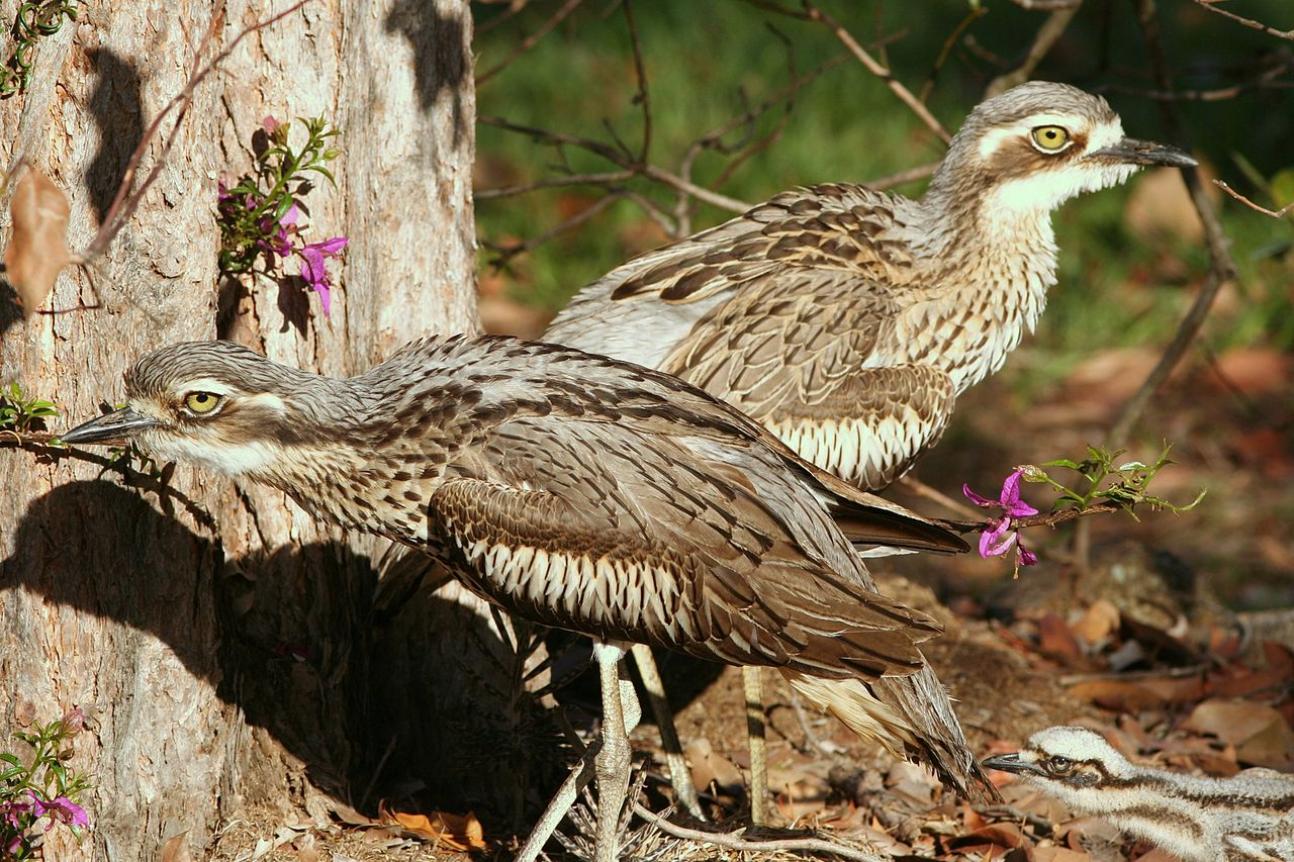
A bush stone curlew has been spotted near Station Beach in recent days. This is now a very rare sighting for Pittwater and quite exciting - although they did once live at Careel Bay as well. This sighting has been reported to Council.
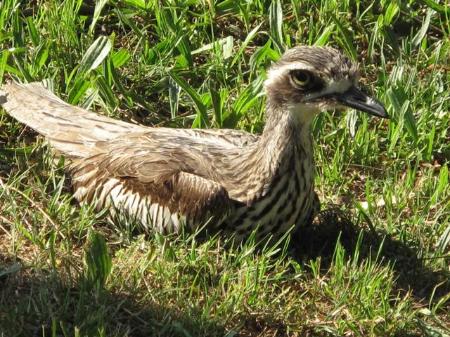
Above: Stone Curlew at North Avalon/Careel Bay, October 2011.
A large, slim, nocturnal, ground-dwelling bird that will build its nest in sand dunes, the bush stone-curlew is now listed as threatened in New South Wales. When breeding, bush stone-curlews create a nest on the ground laying up to 2 eggs between August and October and again between November to January. Each summer endangered pied oystercatchers and little terns, and critically endangered hooded plovers and beach stone curlews, lay their eggs in shallow nests on our beaches.
Unfortunately residents and visitors are taking their dogs offleash into north Palm Beach environs; Station Beach, Barrenjoey National Park, onto North Palm Beach and the into the PB Sand dunes, despite signage clearing stating this is a NO DOGS area. Even if your dog is not interested in the birds, shorebirds will recognise your dog as a predator and leave their nest in fright or attempt to lead the ‘predator’ away. Parent birds are easily disturbed and can abandon nests.
Recent BirdData surveys record Station Beach and Governor Phillip Park are home to a great list of resident bird species and other wildlife.
Similarly many of our creeks and other estuary foreshores are homes to resident shorebirds and a place of refuge for visitor birds during certain seasons.
Birds often seen along Careel Creek include: Pacific Black Ducks, Australian White Ibis, Little Pied Cormorant, White-faced Heron. Unfortunately many of the ducklings are eaten by large eels. As native plants installed by bushcare volunteers grow small birds such as Superb Wren, Spotted Pardalote and White-browed Scrub Wren will forage for insects there. Watch for the mud nests of Magpie Larks in the trees on the western bank.
The Bush Stone-curlew is an endangered species in the Sydney area, but breeds in Careel Bay. During 2011 one was often seen along the creek or nearby. This bird needs open woodland or saltmarsh, with fallen branches to hide among, as it relies on camouflage to protect itself and its nest on the ground.
Locals are calling on the Council to ensure they can live and raise their young in safety and peace across Pittwater and the peninsula.
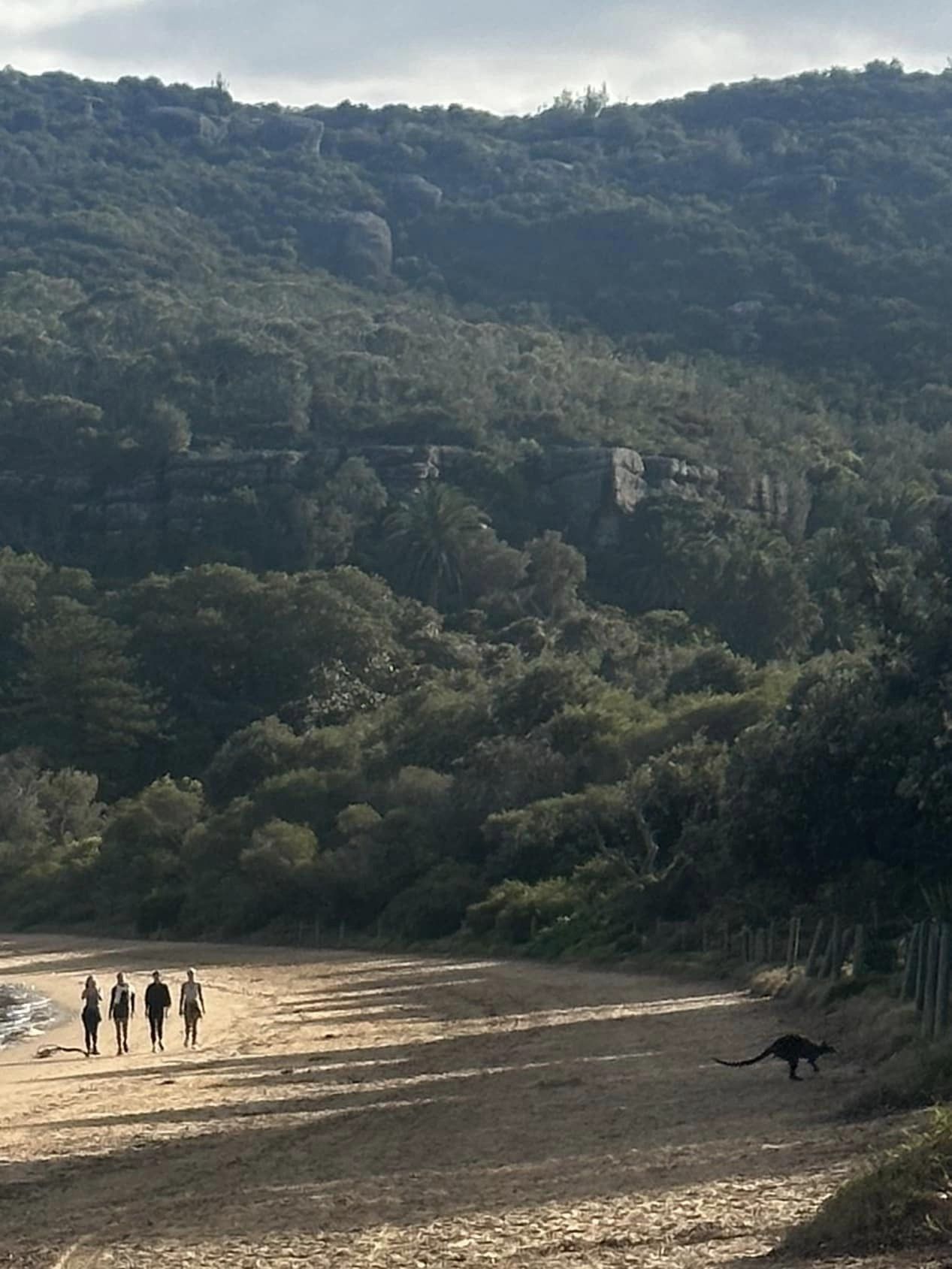
Wallaby going into sand dunes at Station Beach, Thursday August 24 2023, photo supplied.
Dog offleash on Station Beach in 2023, and signage these dog walkers ignored, photos supplied.
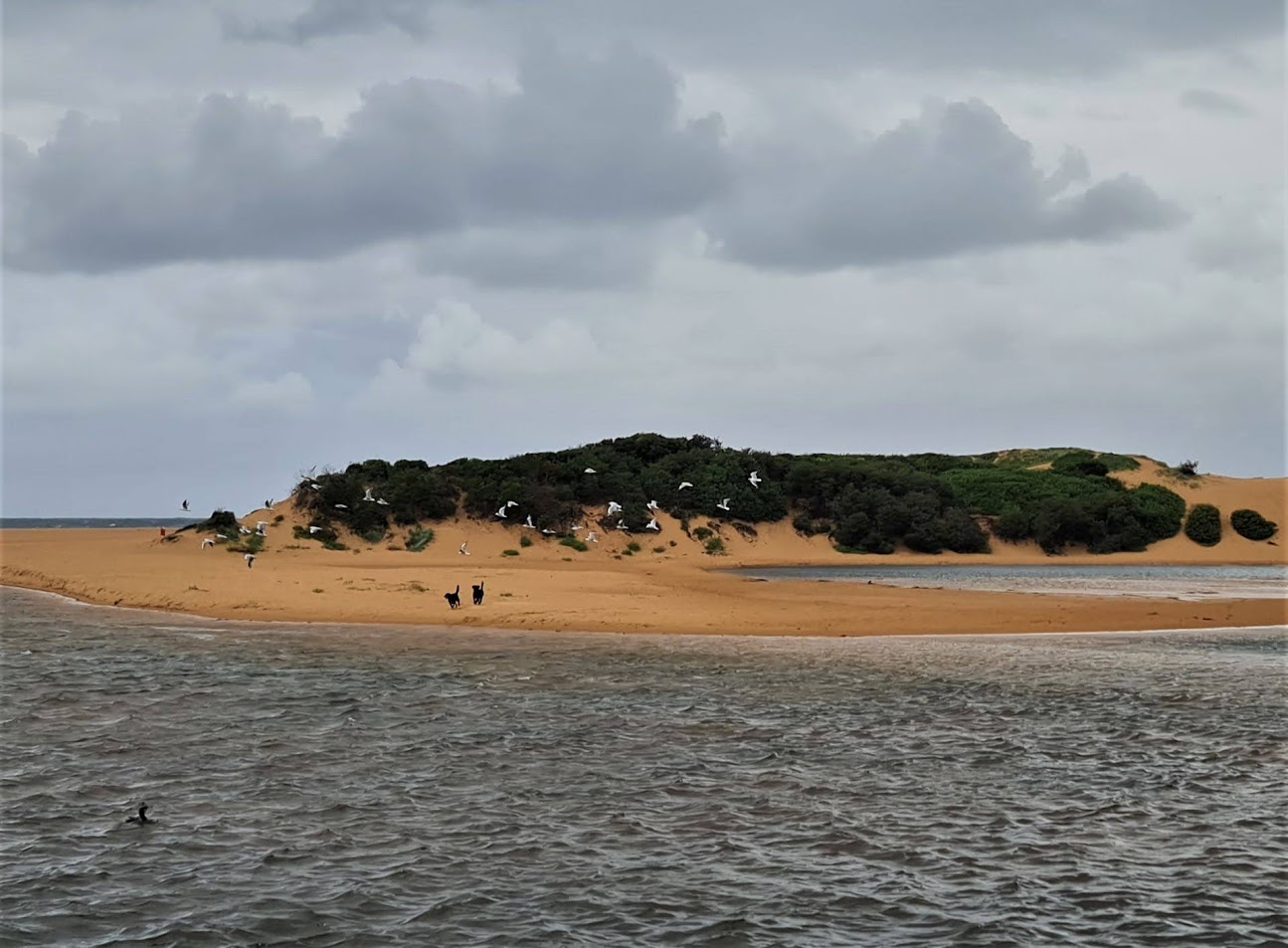
Dogs chasing seagulls off sandbar at North Narrabeen Lagoon January 2024, photo supplied.
The presence of this bird is a great reminder that our area is home to numerous ground-dwelling birds. They live in our wetlands, bush reserves, along our beaches and estuary foreshores.
East Asian—Australasian Flyway
Australia is one of 22 countries within the East Asian—Australasian Flyway and migratory waterbirds reach it via one or more of these countries, e.g. from breeding grounds in Russia or New Zealand.
Shorebird migration is among the most extraordinary feats of travel in the animal kingdom. Each species has its own breeding and non-breeding distribution and habitat preferences. Each has its own migration strategies, flight routes and stopover sites.
Australia is the southern destination for shorebirds using the East Asian—Australasian Flyway and a significant proportion of birds arriving here either stay in Queensland, New South Wales, Victoria or Tasmania, or travel through to New Zealand.
The East Asian-Australasian Flyway Partnership (EAAFP) was launched on 6 November 2006. It aims to protect migratory waterbirds, their habitats and the livelihoods of people dependent upon them. There are currently 40 Partners including 18 national governments, 6 intergovernmental agencies, 14 international NGOs, 1 international organisation and 1 international private enterprise.
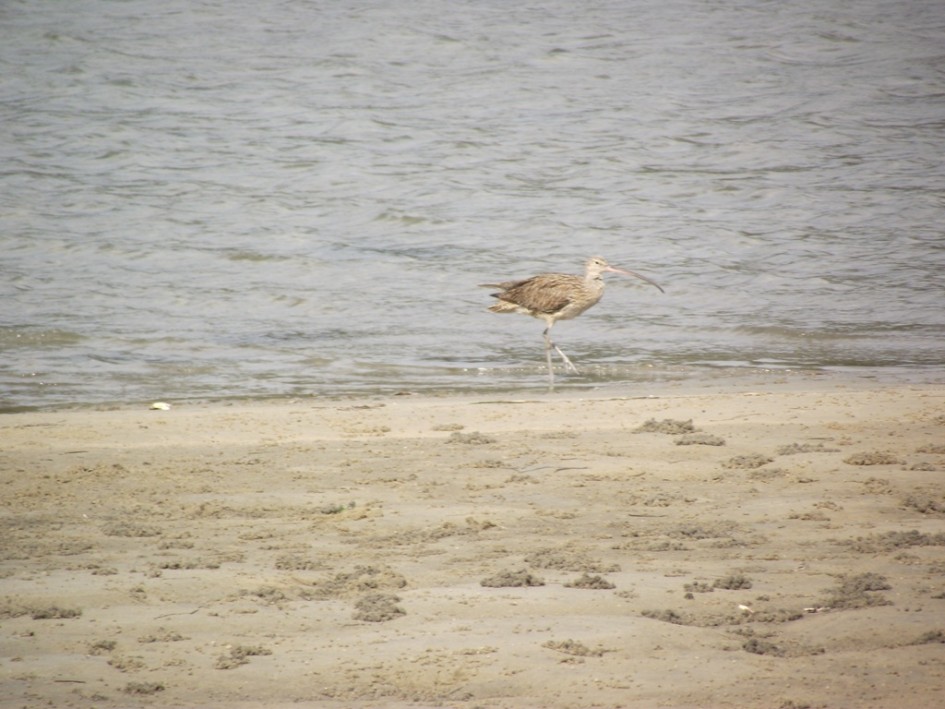
Eastern Curlew at Careel Bay foreshore
The Eastern Curlew is listed as critically endangered under the Environmental Protection and Biodiversity Conservation Act 1999. This species breeds in northern China and Russia during March – August and returns to Australia to feed during summer.
signage at Careel Bay, Pittwater - a place for shorebirds
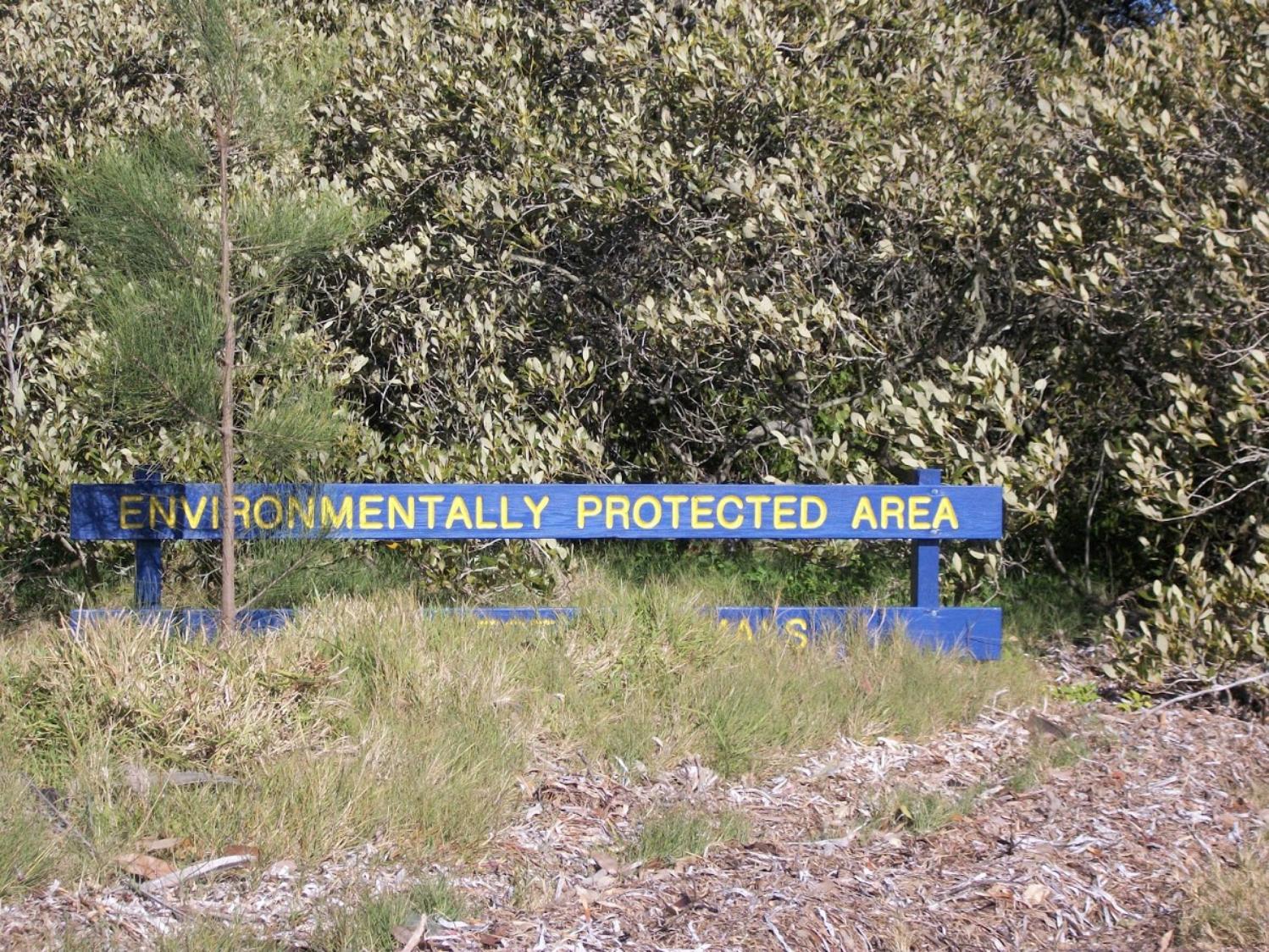
This Issue a few notes on these other residents and visitors of Pittwater and the peninsula. BirdLife Australia's Shorebirds pamphlets for youngsters and Birders is at the base of the page so you may download these for the next time you're out and about.
Some Of Our Beach & Wetlands Birds
These nest on grasses, grass floats, sand, sand dunes, beach grasses alongside sand, and on ground on cliff platforms.
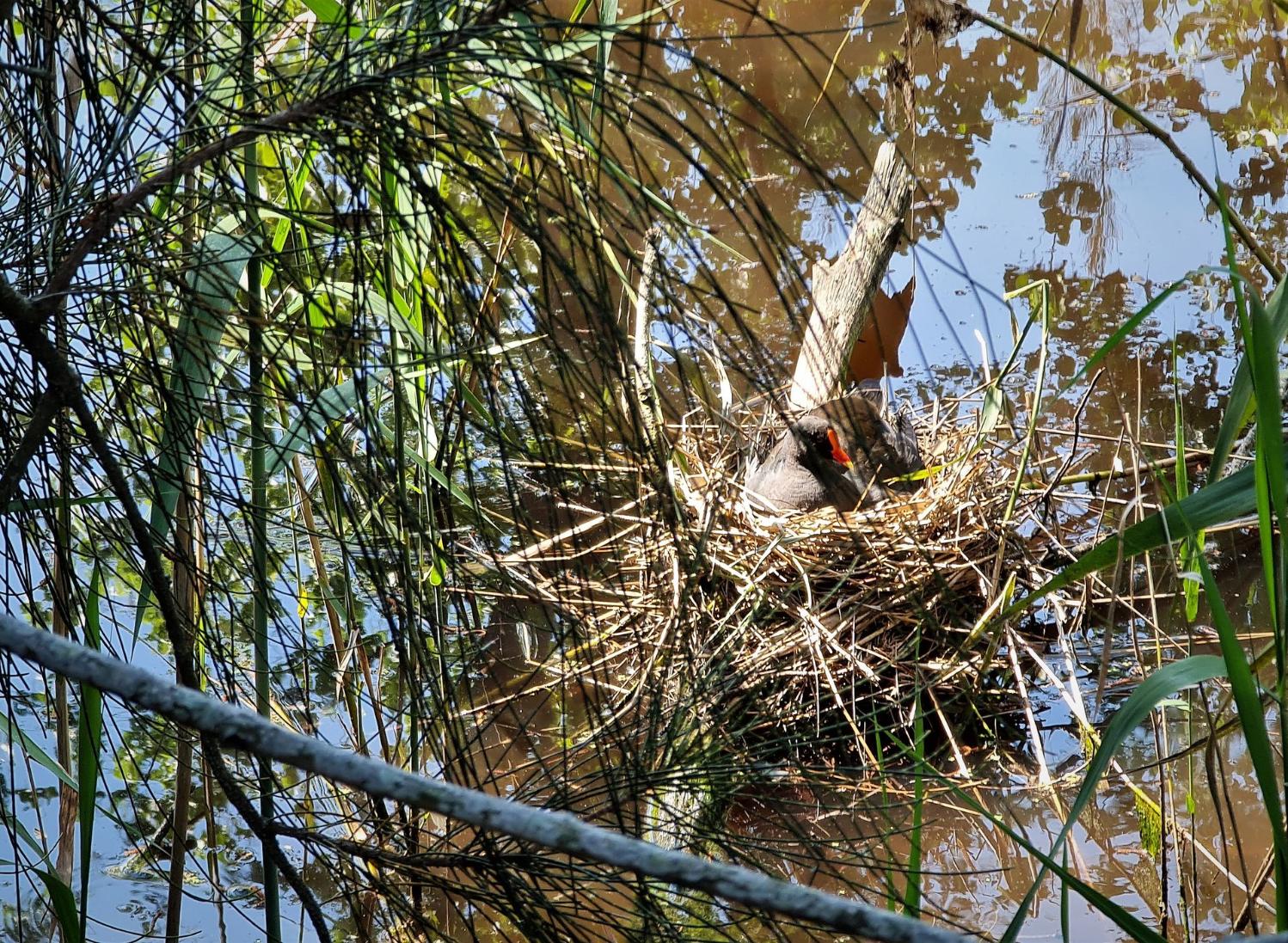
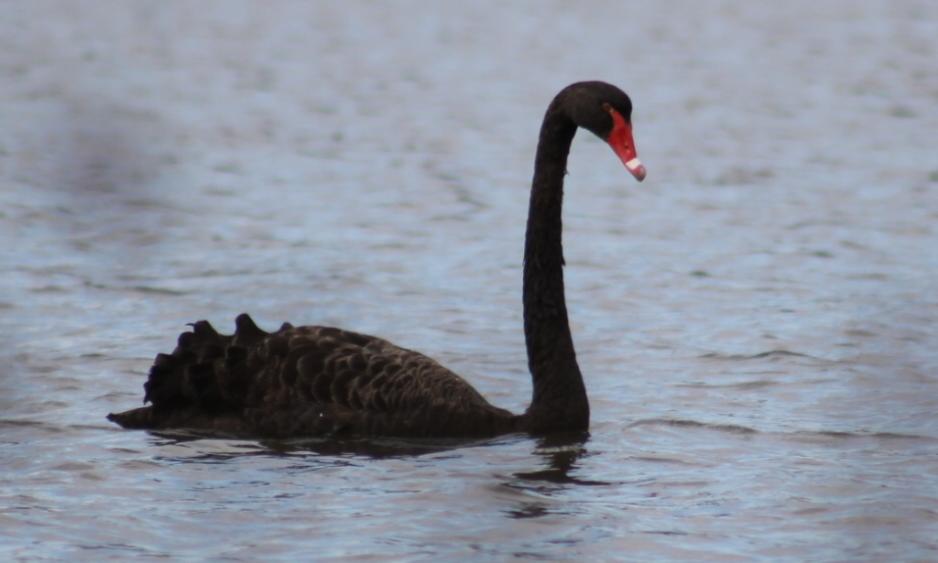
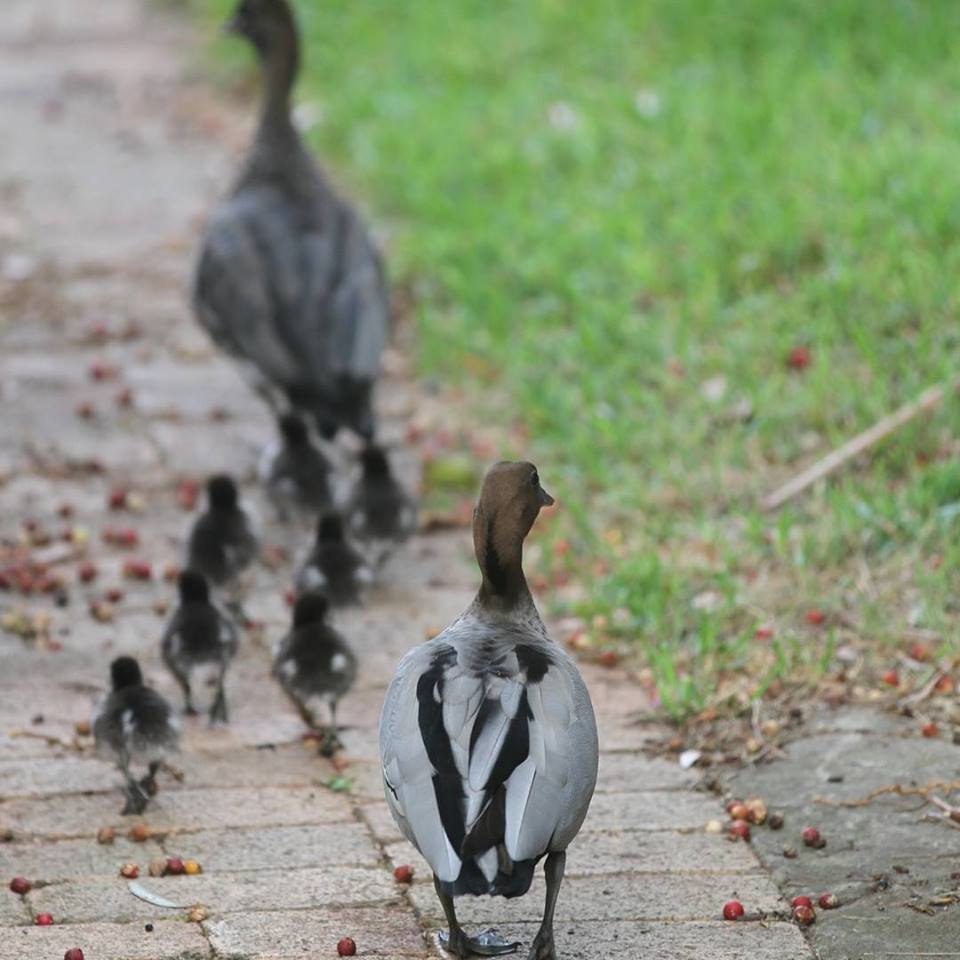
- Pied Oystercatcher
- Sooty Oystercatcher
- Beach Stone-curlew
- Red-capped Plover
- Hooded Plover
- Fairy Tern
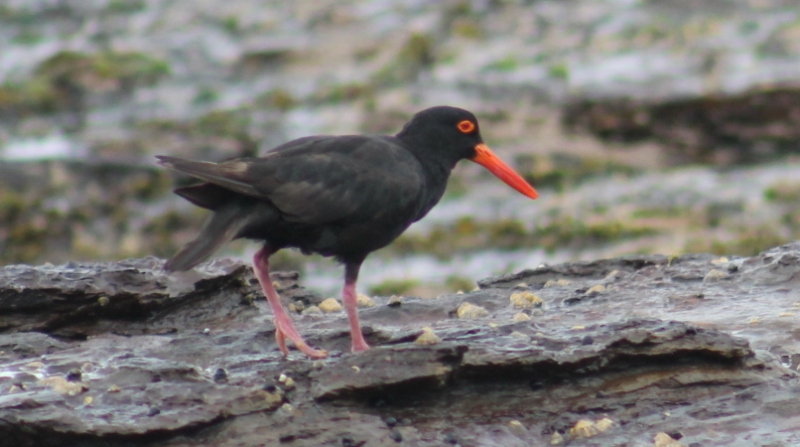
The Sooty Oystercatchers, Haematopus fuliginosus, a Seabird classified among Australia’s Shore birds and waders species, and are a black shorebird with a long red bill, red eye and pink legs. Young birds are duller and browner. It is often seen with the similar Pied Oystercatcher and they are Australia’s only all-black seabird and is found only found in coastal areas. The Sooty Oystercatcher is strictly coastal, usually within 50 m of the ocean. It prefers rocky shores, but will be seen on coral reefs or sandy beaches near mudflats.
- Stone Curlews
- Eastern Curlew, critically endangered
- Beach thick-knee
- Dotterels
- Pied Stilt
- Pied Oystercatcher
- Grey Plover
- Pacific golden Plover
- Lesser Sand Plover
- Greater Sand Plover
- Red-capped Plover
- Black-fronted Dotteral
- Whimbrel
- Far Eastern Curlew
- Bar-tailed Godwit
- Ruddy Tunstone
- Sharp-tailed sandpiper
- Red-necked Stint
- Sanderling
- Grey-tailed Tattler
- Wandering Tattler
- Pomarine Skau
- Pacific Gull
- Brown Noddy
- Black Noddy
- Sooty Tern
- Little Tern
- Caspian Tern
- White-fronted Tern
- Great Crested Tern
- Red-tailed Tropicbird
- Little Penguin (fairy penguin)
- Yellow- nosed Albatross
- White-capped Albatross
- Black-browed Albatross
- Flesh-footed Shearwater
- Wedge-tailed Shearwater
- Respect posted areas, even if you don't see birds inside them. Birds, eggs and nests are well-camouflaged among beach habitat, and disturbance by people can cause the abandonment of a nest.
- Give nesting birds a wide berth
- When fishing, be sure not to leave any equipment behind. Always dispose of fishing line and tackle appropriately.
- Avoid disturbing groups of birds. If birds take flight or appear agitated, you are too close.
- Refrain from walking dogs or allowing cats to roam freely on beaches. Even on a leash, dogs are perceived as predators by nesting birds, sometimes causing adults to abandon nests if disturbed, which leads to the loss of their chicks.
- Don't let pets off boats onto posted islands or beaches around Pittwater - especially the National Park.
- Do not bury or leave rubbish, picnic leftovers, charcoal or fish scraps on the beach. They attract predators of chicks and eggs.
- Beach-nesting birds sometimes nest outside of posted areas. If you notice birds circling noisily over your head, you may be near a nest. Leave quietly, and enjoy observing from a distance.
- Remember you are a visitor in their home and enjoy seeing them but conduct yourself as a good guest; be polite, don't make a mess, and while you don't have to thank them for having you over, perhaps give a thank you to the structures and people that protect these places for birds
Among The Grasses And Fields
Buff Banded Rails
Their nests are usually situated in dense grassy or reedy vegetation close to water, with a clutch size of 3-4.
The Buff-banded Rail (Gallirallus philippensis) is a distinctively coloured, highly dispersive, medium-sized rail of the family Rallidae. This species comprises several subspecies found throughout much of Australasia and the south-west Pacific region, including the Philippines(where it is known as Tikling), New Guinea, Australia, New Zealand (where it is known as the Banded Rail or Moho-pereru in Māori)
They feed on snails, crabs, spiders, beetles and worms, feeding at dawn, dusk and after high tide. They can run at great speed but seldom take to flight.
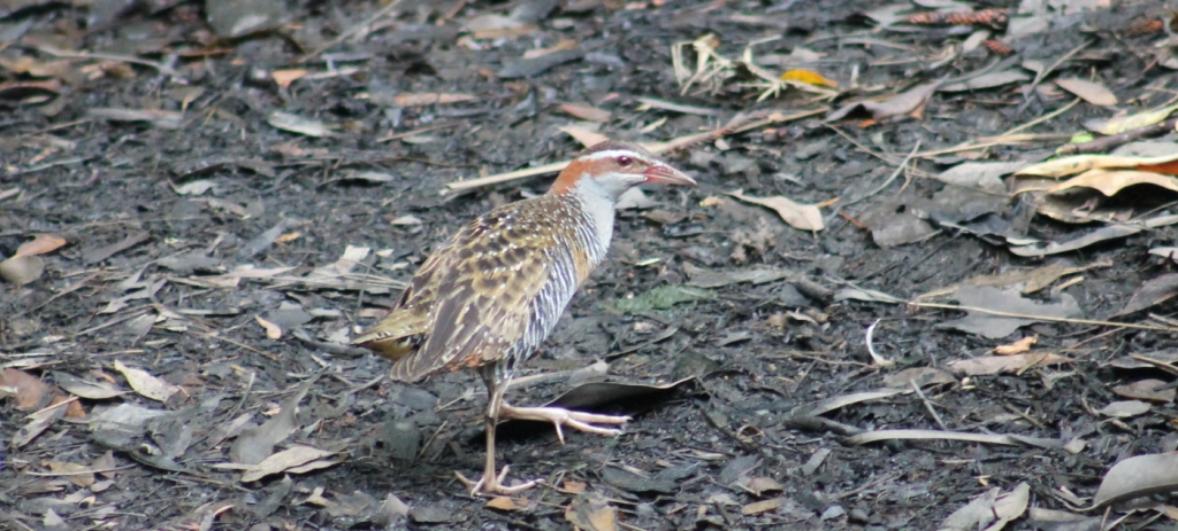
The mum.
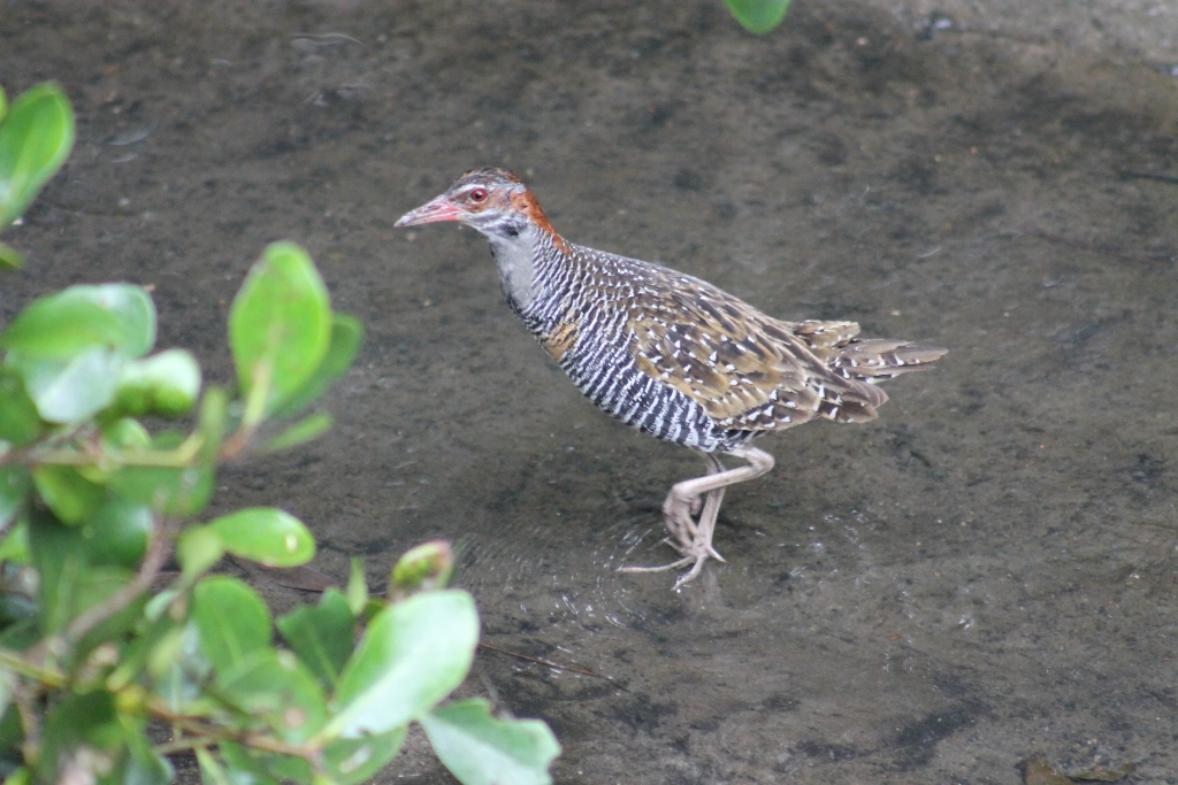
The dad. Photos: A J Guesdon
Masked Lapwing (plover)
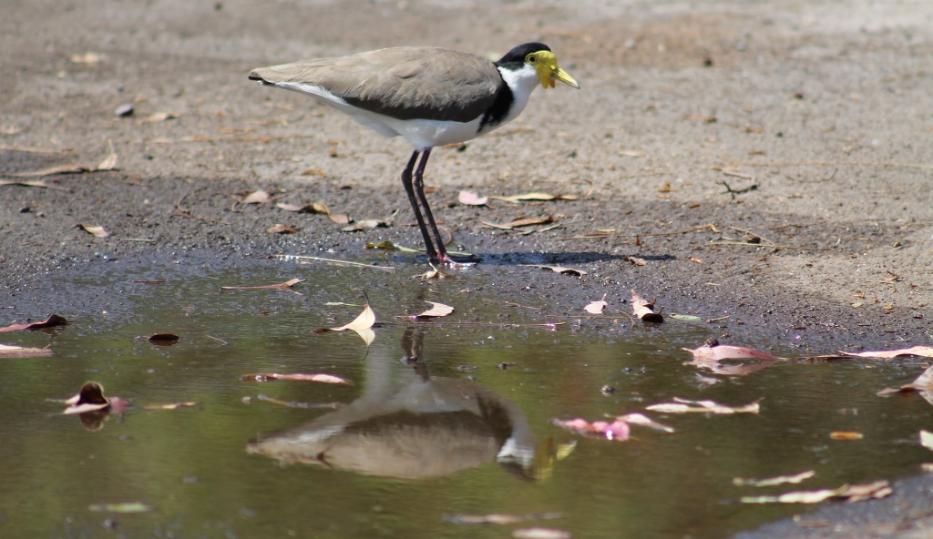
Masked Lapwing Plover - photo by A J Guesdon
The Masked Lapwing (Vanellus miles; name from the Latin for soldier and refers to the spurs, which give an armed appearance), previously known as the Masked Plover and often called the Spur-winged Plover or just Plover in its native range, is a large, common and conspicuous bird native to Australia. Its Aboriginal name: ‘baaldarradharra’.
This species is the largest representative of the family Charadriidae, at 35 cm (14 in) and 370 g (13 oz). The subspecies found in the southern and eastern states (Vanellus miles novaehollandiae), and often locally called the Spur-winged Plover, has a black neck-stripe and smaller wattles.
Masked Lapwings are most common around the edges of wetlands and in other moist, open environments, but are adaptable and can often be found in surprisingly arid areas. They can also be found on beaches and coastlines.
They make their nest in little hollows on the ground. The nesting pair defends their territory against all intruders by calling loudly, spreading their wings, and then swooping fast and low, and where necessary striking at interlopers with their feet and attacking animals on the ground with a conspicuous yellow spur on the carpal joint of the wing.
The bird may also use tactics such as fiercely protecting a non-existent nest, or a distraction display of hopping on a single leg, to attract a potential predator's attention to itself and away from its real nest or its chicks after they have commenced foraging. There seems to be some significant use of language to guide chicks during a perceived dangerous situation. Long calls seem to tell the chicks to come closer to the calling bird; a single chirp every few seconds to ask them to move away.
There is a much-believed but incorrect myth that the spur can inject venom. The myth may have been based on fear of the Masked Lapwing's territorial behaviour. Attacks are most vicious on other birds such as ravens, and also on cats and dogs, but once the chicks reach 60% of full size after 2–3 months, the chances of this happening decrease. Strikes are much rarer on humans since they are more aware. Sometimes the bird can damage its wing in a strike but usually survives and is flightless until the wing heals.
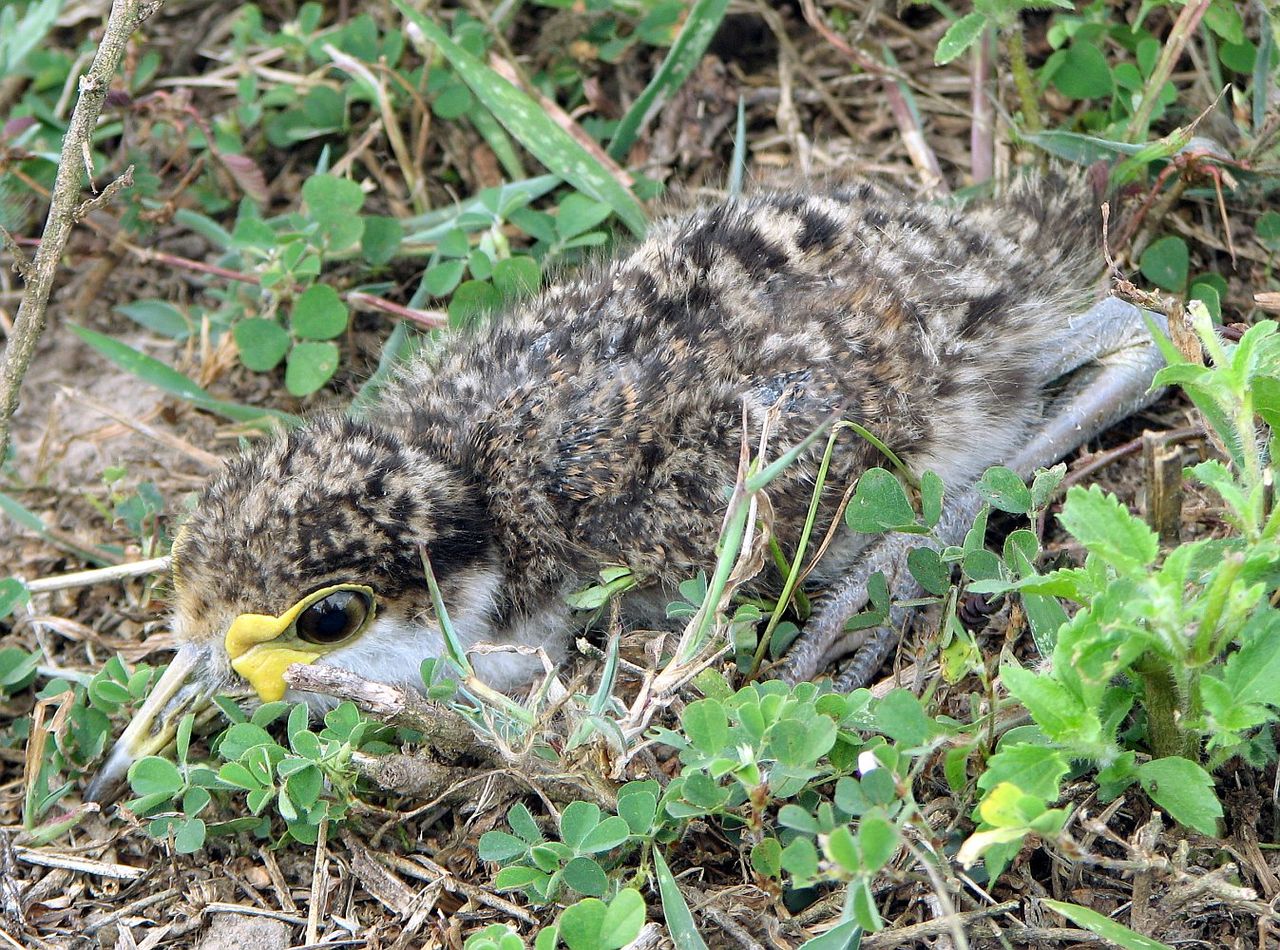
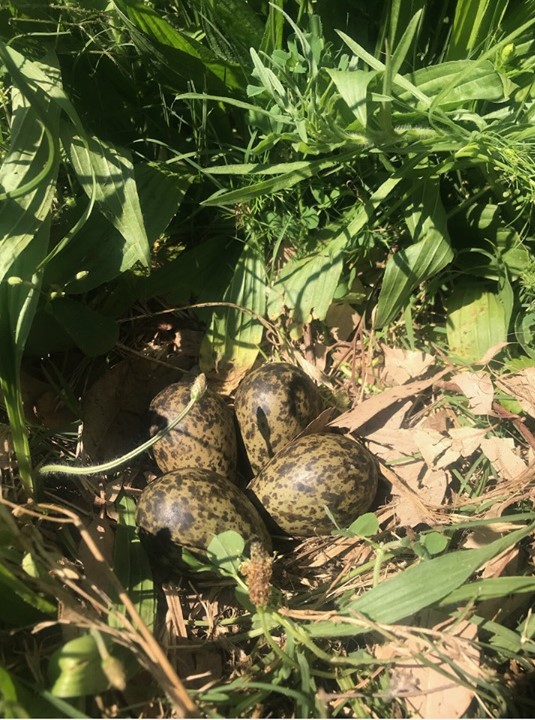
Photos: Young birds crouch and lie still when threatened - photo by Amos T Fairchild + A nest in m the grass at Mona Vale - photo by Margaret Woods
Painted Button-quail
The female builds a domed nest of leaves, sticks and grasses beneath a tussock of grass, or at the foot of a rock or sapling, and lays 3-4 eggs at a 2-3 day laying interval between each egg. The male incubates the eggs once the clutch is complete, and all the eggs hatch at the same time. The chicks leave the nest immediately and are only fed by the male for 7-10 days. The chicks can fly 10 days after leaving the nest. The painted buttonquail is about 19 to 20 cm (7.5 to 7.9 in) long. It is a ground-dwelling bird and is found in grassy forests and woodlands. It feeds on insects and seeds. Often the first sign that a Painted Button-quail is present in a dry, open forest is not a sighting of the bird, nor hearing its call, but a shallow depression of bare soil among the leaf litter. These bare patches, round and about 15 centimetres across, are called platelets or 'soup-plates'. Painted Button-quails forage for seeds and insects on the ground by spinning about on alternate legs to expose items of food among the leaves and on the soil surface, and it is this action that forms the platelets.
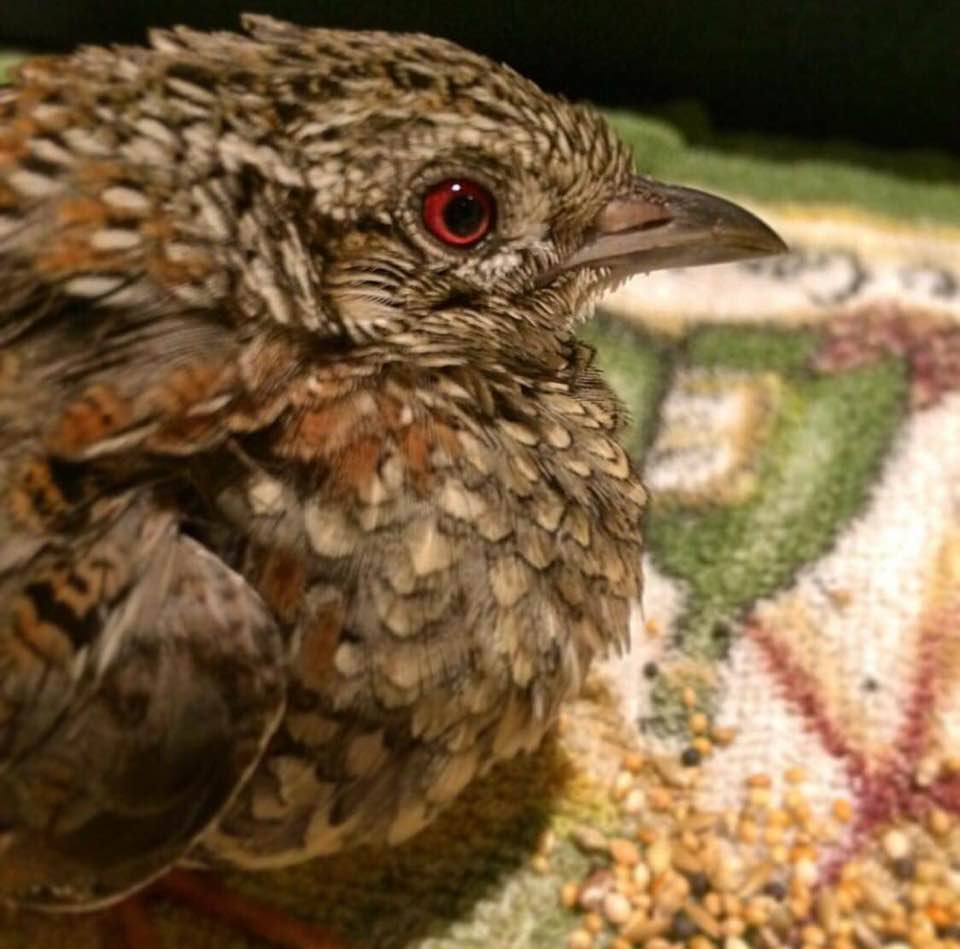
A Painted Button-quail rescued in Elanora Heights - photo by Lynleigh Greig
Painted Button Quail are active during the early evening from dusk on, at night and early morning, feeding on the ground. They are usually seen in pairs or small family parties, searching for seeds, fruit, leaves and insects.
Brush Turkeys
Brush- turkeys or Bush Turkeys (Alectura lathami) as they are sometimes called, belong to the megapodes family, meaning that they are incubator birds or mound-builders, and build large nests in which to incubate their eggs; the heat generated, like in compost bins, from these mounds of leaves is what incubates the eggs. The males build the nests.
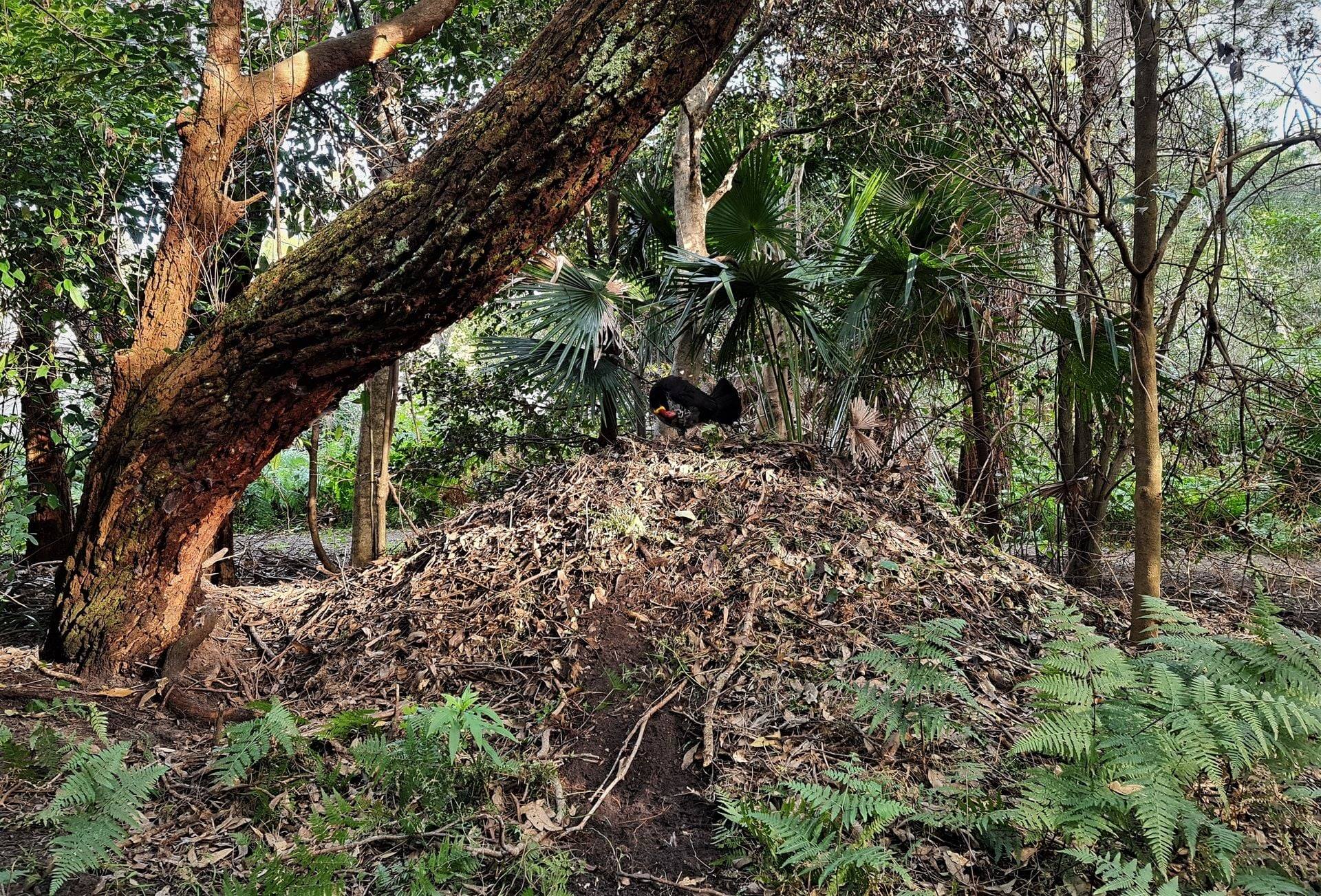
Brush/Bush Turkey nest at Irrawong Falls, Warriewood/Ingleside, July 7th, 2021 - photo by Joe Mills
Their name megapode literally means "large foot" (Greek: mega = large, poda = foot), and is a reference to the heavy legs and feet typical of these terrestrial birds. Several females will lay their eggs in the one mound (up to 30 eggs can be there although the average is 18-24) and the chicks are unusual among birds as they will hatch fully feathered and be able to fly within a few hours – a good thing as these birds are ground dwellers or not predisposed to flying for long times, although they can. They are able to run fast and jump over fences quite easily. Lyre birds are also ground dwellers.
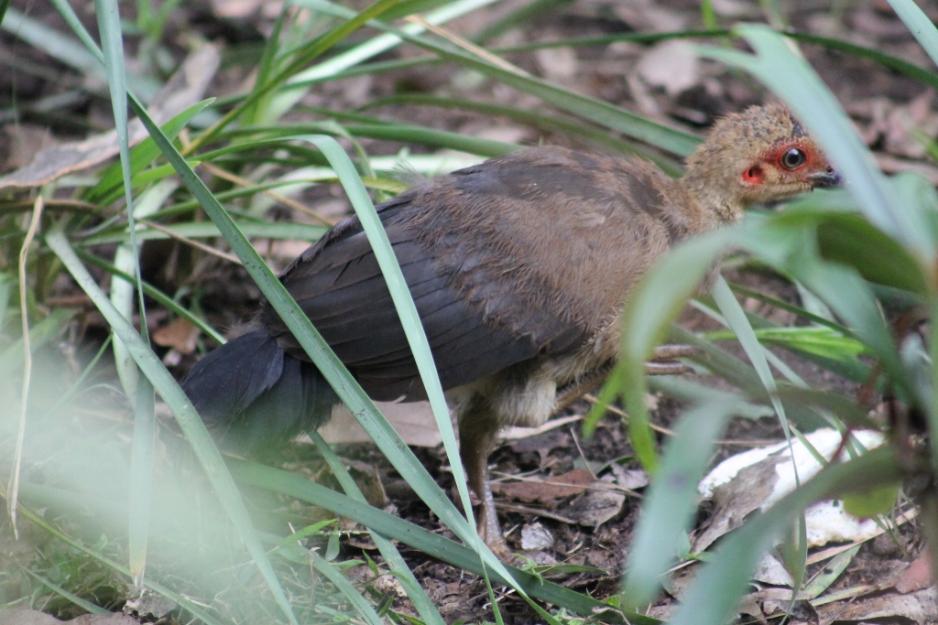
A young Brush-turkey that was scratching around in a backyard at Careel Bay - this 'troop' seem to come through this garden generation after generation and have done so for decades
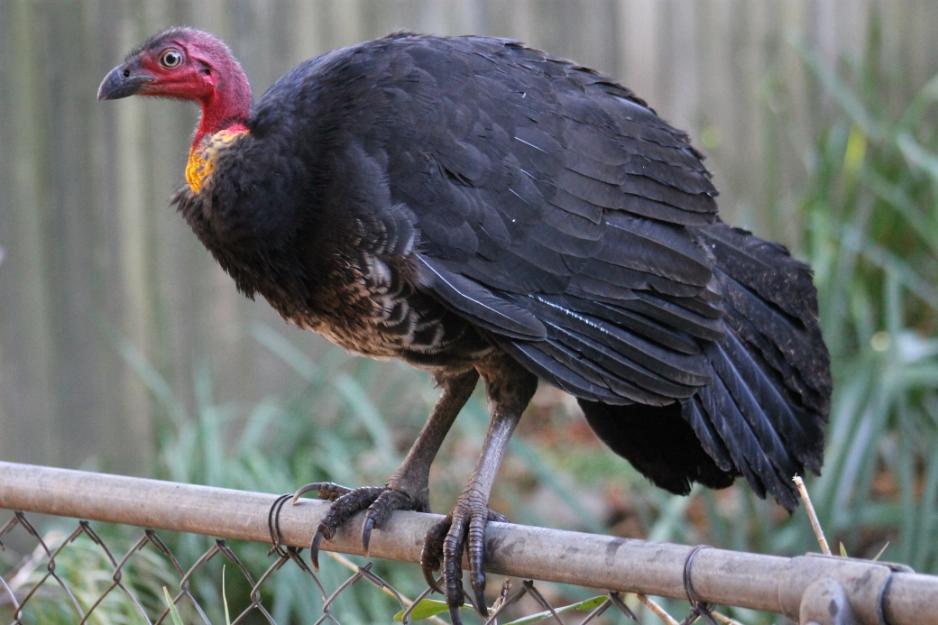
One of the parents pausing long enough to say 'good morning!'
Lyrebirds
There are 2 species in the family of lyrebirds - the superb lyrebird and the Albert's lyrebird. It is the superb lyrebird which gives the family its name. Its spectacular tail of fanned feathers, when spread out in display, looks like a lyre (a musical instrument of ancient Greece).
The male superb lyrebird is 80-100 centimetres long, including his 55-centimetre-long tail. He is dark brown on the upper part of his body and lighter brown below, with red-brown markings on his throat. His tail feathers are dark brown above and silver-grey below.
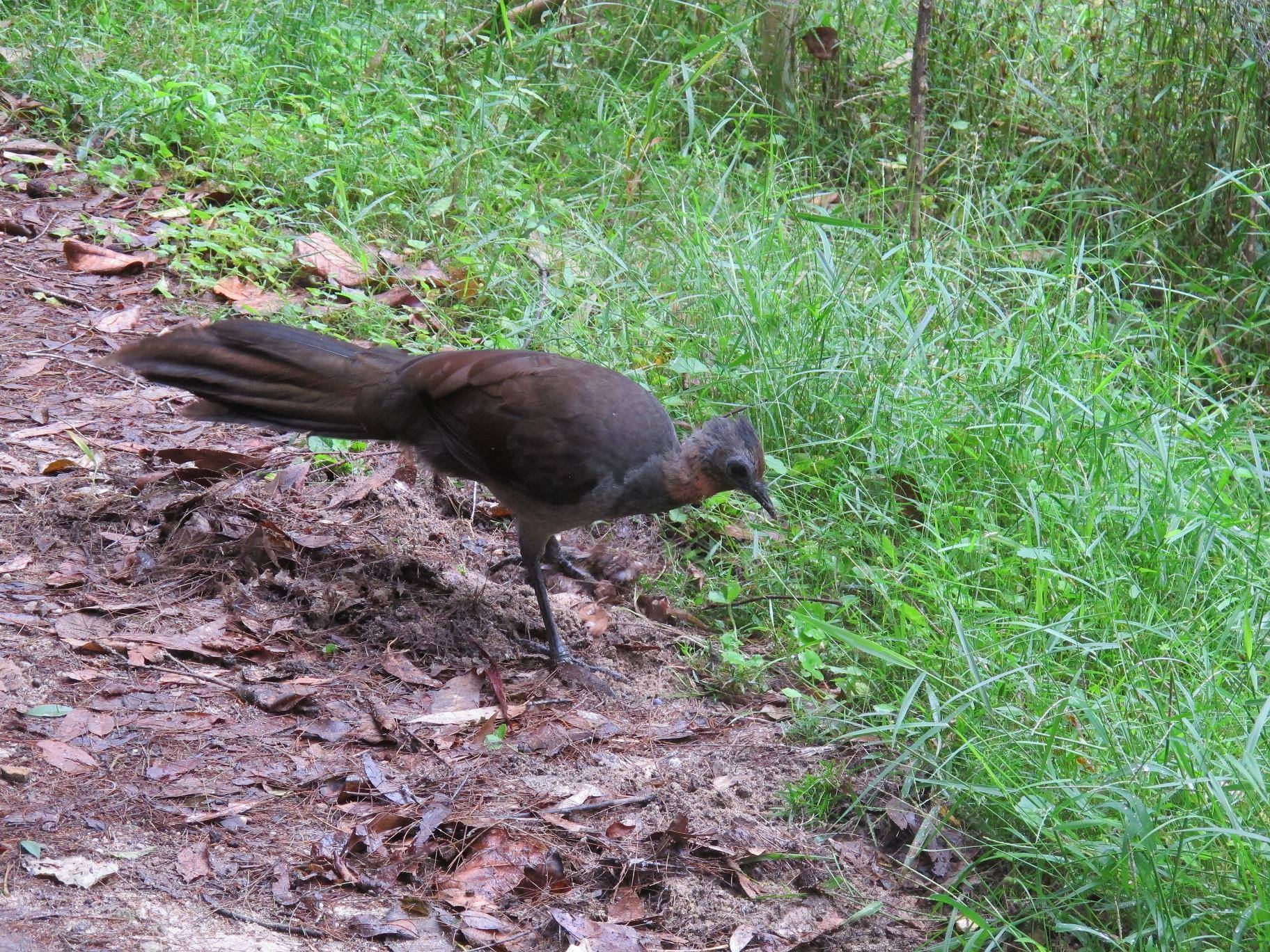
Lyrebird at Irrawong Falls, Warriewood - these are also seen/heard from West Pittwater to Whale/Palm Beach
Females of the species are smaller than the males, with similar colouring but without the lyre-shaped tail. The females' tail feathers are broadly webbed with reddish markings. Young male superb lyrebirds do not grow their lyre tails until they are three or four years old. Until this time, they usually group together and are known as 'plain-tails'.
The Albert's lyrebird is similar in appearance to the superb lyrebird, but is smaller and darker, with a rich chestnut colour. The male does not have the outer lyre-shaped tail feathers of the superb lyrebird. The Albert's lyrebird is listed as vulnerable in NSW.
The display period for both species is from May to August, with breeding occurring mainly in June and July. Females are attracted to the mound by the male's display and song. Male birds will mate with several females, and although they appear to know where the nests are, they take no part in building them or incubating and feeding the young.
The female builds a dome-shaped nest of sticks, which can be on the ground, on rocks, within tree stumps, or in tree ferns and caves. The nest is lined with ferns, feathers, moss and rootlets. Usually, only 1 egg is laid, which hatches in around 6 weeks. The young lyrebird remains in the nest for 6 to 10 weeks.
Lyrebirds are very shy birds. When threatened, they escape by running and dodging rapidly through the undergrowth emitting high-pitched shrieks of alarm. With their short, round, weakly-muscled wings they too are one of our ground-nesting birds that rarely fly. However, their wings allow them to jump onto tree branches or rocks - and then glide back down to the forest floor.
New Shorebirds WingThing For Youngsters Available To Download
A Shorebirds WingThing educational brochure for kids (A5) helps children learn about shorebirds, their life and journey. The 2021 revised brochure version was published in February 2021 and is available now. You can download a file copy here.
If you would like a free print copy of this brochure, please send a self-addressed envelope with A$1.10 postage (or larger if you would like it unfolded) affixed to: BirdLife Australia, Shorebird WingThing Request, 2-05Shorebird WingThing/60 Leicester St, Carlton VIC 3053.

 Shorebird Identification Booklet
Shorebird Identification Booklet
The Migratory Shorebird Program has just released the third edition of its hugely popular Shorebird Identification Booklet. The team has thoroughly revised and updated this pocket-sized companion for all shorebird counters and interested birders, with lots of useful information on our most common shorebirds, key identification features, sighting distribution maps and short articles on some of BirdLife’s shorebird activities.
The booklet can be downloaded here in PDF file format: http://www.birdlife.org.au/documents/Shorebird_ID_Booklet_V3.pdf
Paper copies can be ordered as well, see http://www.birdlife.org.au/projects/shorebirds-2020/counter-resources for details.
Download BirdLife Australia's children’s education kit to help them learn more about our wading birdlife
Shorebirds are a group of wading birds that can be found feeding on swamps, tidal mudflats, estuaries, beaches and open country. For many people, shorebirds are just those brown birds feeding a long way out on the mud but they are actually a remarkably diverse collection of birds including stilts, sandpipers, snipe, curlews, godwits, plovers and oystercatchers. Each species is superbly adapted to suit its preferred habitat. The Red-necked Stint is as small as a sparrow, with relatively short legs and bill that it pecks food from the surface of the mud with, whereas the Eastern Curlew is over two feet long with a exceptionally long legs and a massively curved beak that it thrusts deep down into the mud to pull out crabs, worms and other creatures hidden below the surface.
Some shorebirds are fairly drab in plumage, especially when they are visiting Australia in their non-breeding season, but when they migrate to their Arctic nesting grounds, they develop a vibrant flush of bright colours to attract a mate. We have 37 types of shorebirds that annually migrate to Australia on some of the most lengthy and arduous journeys in the animal kingdom, but there are also 18 shorebirds that call Australia home all year round.
What all our shorebirds have in common—be they large or small, seasoned traveller or homebody, brightly coloured or in muted tones—is that each species needs adequate safe areas where they can successfully feed and breed.
The National Shorebird Monitoring Program is managed and supported by BirdLife Australia.
This project is supported by Glenelg Hopkins Catchment Management Authority and Hunter Local Land Services through funding from the Australian Government’s National Landcare Program. Funding from Helen Macpherson Smith Trust and Port Phillip Bay Fund is acknowledged.
The National Shorebird Monitoring Program is made possible with the help of over 1,600 volunteers working in coastal and inland habitats all over Australia.
The National Shorebird Monitoring program (started as the Shorebirds 2020 project initiated to re-invigorate monitoring around Australia) is raising awareness of how incredible shorebirds are, and actively engaging the community to participate in gathering information needed to conserve shorebirds.
In the short term, the destruction of tidal ecosystems will need to be stopped, and our program is designed to strengthen the case for protecting these important habitats.
In the long term, there will be a need to mitigate against the likely effects of climate change on a species that travels across the entire range of latitudes where impacts are likely.
The identification and protection of critical areas for shorebirds will need to continue in order to guard against the potential threats associated with habitats in close proximity to nearly half the human population.
Here in Australia, the place where these birds grow up and spend most of their lives, continued monitoring is necessary to inform the best management practice to maintain shorebird populations.
BirdLife Australia believe that we can help secure a brighter future for these remarkable birds by educating stakeholders, gathering information on how and why shorebird populations are changing, and working to grow the community of people who care about shorebirds.
To find out more visit: http://www.birdlife.org.au/projects/shorebirds-2020/shorebirds-2020-program
Our Dogs Can Terrify (And Even Kill) Wildlife. Here’s How To Be A Responsible Owner This Summer
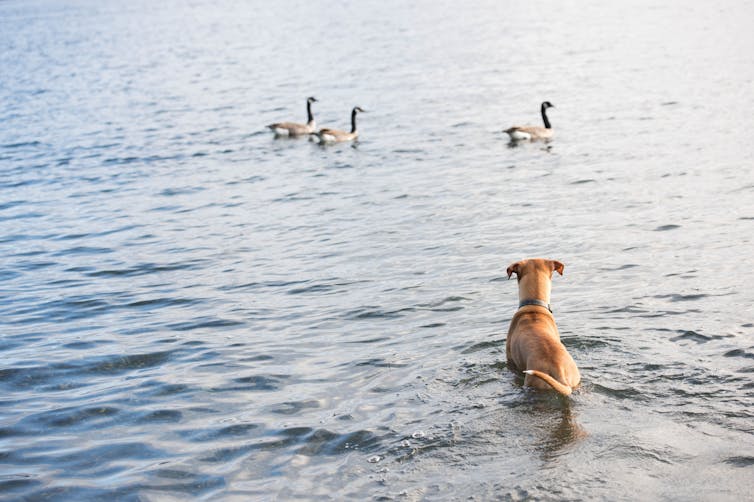
In Australia, dog ownership often goes hand-in-hand with a love for the great outdoors. Whether it’s walking on the beach, going camping, or having a barbecue in the park, we tend to keep our canine companions close as we soak up the sun.
But many of us forget a key fact about our dogs: they are predators. Even the fluffy little 5kg ball that spends most of its time in your lap derives from an apex predator – and its predatory instincts can kick in at any time.
And while many of our dogs don’t have the same hunting skills as their distant ancestors (who had to hunt for a living), wildlife doesn’t know that.
The impacts of domestic dogs on wildlife aren’t well studied, and likely vary depending on the environment. Nonetheless, there’s good evidence domestic dogs, when left unobserved, can have detrimental effects in the places they visit.
With that in mind, here are some things to consider next time you take your pup out for a bushwalk.
How Dogs Impact Ecosystems
There are five main ways domestic dogs can negatively impact the natural environments they visit. These are:
- direct physical harm through predatory behaviour
- disturbance through chasing and harassment
- increased exposure to diseases
- interbreeding, which can alter the gene pool of wild canid populations
- increased competition for resources.
The good news is the last three points aren’t particularly relevant in Australia. For one thing, there’s little overlap between diseases common in domestic dogs and Australian wildlife. There’s also little resource overlap, except perhaps in some areas where feral or semi-feral dogs live alongside dingoes.
And regarding potential interbreeding, while it was once thought this could threaten the dingo gene pool, recent research suggests it’s not nearly as common as we thought.
As such, the main harms Aussie dog owners should focus on are physical harms through predatory behaviour and disturbance to ecosystems.

Dogs Can Kill
We know dogs are capable of injuring and killing wildlife, but it’s difficult to determine how common this is, because many events go unreported. While smaller animals such as lizards, gliders and possums are at higher risk, larger species such as koalas can also fall prey to dogs.
One study that looked at wildlife coming into care at Queensland rehabilitation centres reported dog attacks as the cause in about 9% of cases. These cases often resulted in severe injury or death.
Dog owners should be especially wary of small, localised populations of vulnerable species. A study in Argentina’s Patagonia region details several cases of dogs decimating local penguin populations after gaining access to protected island areas during low tide.
Not to mention, dog attacks on wildlife can bring risk to dogs as well. Kangaroos can defend themselves with their powerful limbs, monitor lizards are equipped with sharp claws and teeth, and many snake species are highly venomous.
The Impact Of Harassment
You might think it’s harmless for your dog to chase wildlife if it never manages to catch the animals it chases, but that isn’t true. Wild animals optimise their behaviours to meet their needs for foraging, breeding and resting, and being chased by a dog can disrupt this.
For example, certain threatened bird species will nest on the beach and find foraging opportunities based on the tides. One dog forcing one bird to abandon this important activity may have a small impact. But if it happens repeatedly throughout the day, it can become a much bigger problem. It may even drive animals out of the area.
Research conducted in Sydney has shown the mere presence of a leashed dog is enough to temporarily, yet dramatically, reduce the number of bird species detected.
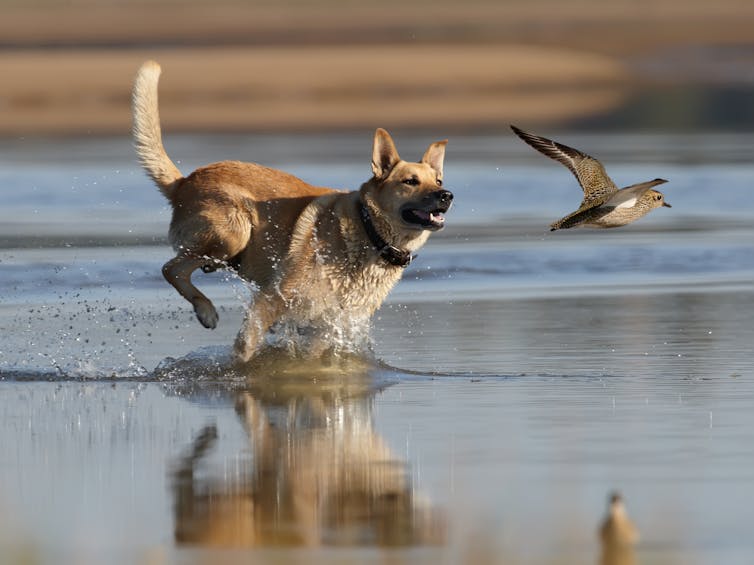
Keep An Eye On Your Furry Pal
Responsible dog ownership involves making sure our dogs have a minimal impact on others, including wildlife. How can we achieve this when our dogs are simply engaging in behaviours that come naturally to them, and may even be rewarding for them?
Training your dog to have general obedience – especially to come when called – is worth sinking considerable time and effort into. This can save both your dog and any wildlife they may be after. For instance, calling a dog away from a snake is one of the most effective ways of managing snake bite risk.
One pilot study in Victoria found positive outcomes from a program that helped owners train their dogs to be more obedient around wildlife.
That said, recall training is an art form, and recalling a dog that likes to run off and chase animals can be a huge challenge.
Another solution is to rely on leashes when passing sensitive areas, or where there’s a risk of wildlife harassment. In Australia, many beaches that allow dogs have signs with information about vulnerable birds in the area and how to protect them from your dog.
This could mean keeping your dog off rock platforms, leashing them when you see birds foraging on the beach, or keeping them out of fenced areas. Some areas are simply too vulnerable for dogs to run amok, so always look for signs and read them carefully.
If you’re hiking, use a long line (a leash that’s more than five metres long) and look for signs of your dog detecting something of interest. Often their ears will come up high and forward, and they will freeze and stare intently.
At this point, it doesn’t matter what they’re excited about: take the opportunity to leash them or shorten their leash, and get their attention before they can take off. Investing in a long leash will allow your dog more freedom without putting wildlife at risk.
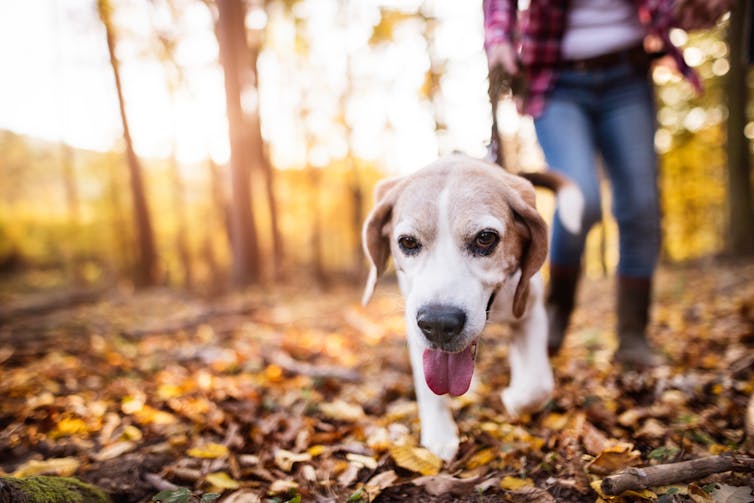
If your dog does injure an animal, you should quickly contact a wildlife rescue organisation or take the animal to a veterinary practice or sanctuary. For small animals, even minor injuries from a dog will usually require veterinary attention.
It’s our responsibility to be respectful visitors when we’re out in nature, and to make sure our dogs are too. ![]()
Melissa Starling, Postdoctoral Researcher in Veterinary Science, University of Sydney
This article is republished from The Conversation under a Creative Commons license. Read the original article.
Dusky Moorhen in Careel Creek, Saturday October 30, 2021 - photos by A J Guesdon
Dusky Moorhen in Careel Creek, Thursday November 30, 2021 - photos by A J Guesdon